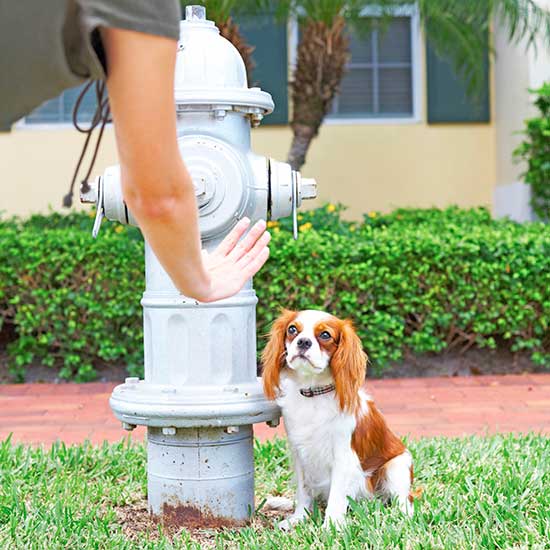Potty training is one of the most important steps both a dog and their owner can take during the early stages of a puppy’s life, whether you train them outdoors or on a pee pad indoors, how you train your pup will help shape them into an independent dog. Dog owners need to be patient when learning how to potty train a puppy and they need to have even more patience for the puppy during the training process. Some puppies may take several months to independently go to the bathroom, but hopefully this article can get you there quicker! Here we’ll look at how to potty train a puppy and some great trips for potty training a puppy.
How To Potty Train A Puppy
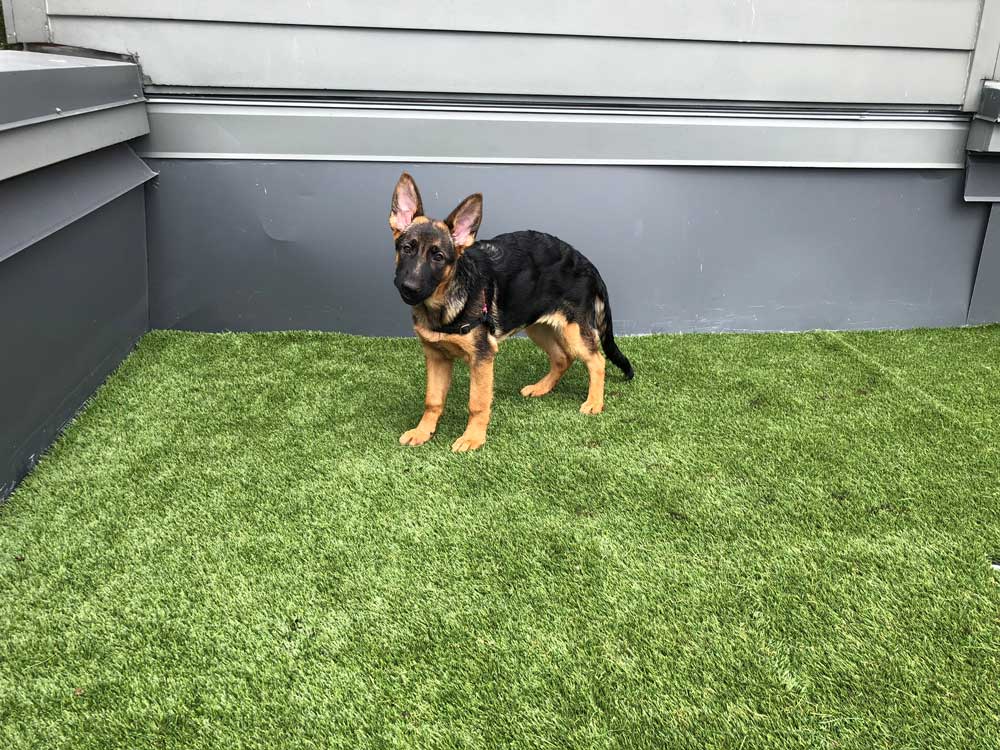
When starting the potty training process with your puppy it’s important to make sure you have a plan and schedule that reflects how much time you can spend training your new puppy. Luckily for you a puppy’s routine is fairly predictable, they typically need to go to the bathroom immediately when they wake up, so it’s imperative to take them out as soon as they wake up. About 15-20 minutes after they eat they will also want to urinate and then defecate within a half hour to an hour, each dog will be unique but you can follow this lose guideline until you better understand your puppy’s bathroom agenda.
When establishing a routine you should remember that just like a human baby puppies do their best on a regular schedule. The longer you make your puppy hold their bladder the more likely they are to have an accident. Here we’ve put together tips for potty training a puppy:
Take them outside regularly
You should be taking your puppy outside at least every 2 hours. You should also be taking them out immediately after the wake up in the morning, after they play (sometimes during) and shortly after they eat and drink. Keep in mind their body and organs are still very small and that they don’t have a lot of room to store their waste.
Select a designated bathroom area outside
This is where conditioning comes into play. Selecting the same spot every time will help your puppy understand that this is the area where they eliminate their waste. While the puppy relieves themselves at the certain spot make sure to use a word or phrase that you can repeat next time to remind them that that it’s time to use the bathroom. Make sure to take them out on their leash to this spot as well, it gives you control over the situation and you don’t need to be chasing a peeing puppy all over your backyard.
Reward your puppy
Give your puppy a treat every time they relieve themselves, make sure to give it to them right after they finish, not later on. Like any puppy, rewarding them with a dog treat is one of the most efficient wants to teach them what is expected of them.
Schedule when your puppy eats
As puppies grow they need to be fed puppy food on a regular basis, anywhere from 3-4 times per day. If you feed them the same time everyday they are more likely to go to the bathroom shortly after. This sets up a bathroom schedule to where you’re certain they will have to go, inadvertently creating a bathroom schedule as well.
Limit access to their water dish
Around 2-3 hours before bed make sure you put away the puppy’s water dish, this will stop your puppy from drinking a bunch of water right before you tuck them into bed.
Use their crate when no one is home
Putting them into their crate while the house is empty helps limit accidents throughout the house when you aren’t there to see the cues.
Another great tip for potty training a puppy is making sure they are supervised on a regular basis while indoors. Some people have been known to tether their puppy up when they are just lying around the house. Being tied up indoors will force them to show some sort of emotion indicating they need to relieve themselves, signs include barking, scratching, squatting or circling the same spot. If they show these signs you should take them outside to their designated spot. Don’t forget to praise them with a reward if they do eliminate.
Crate Potty Training
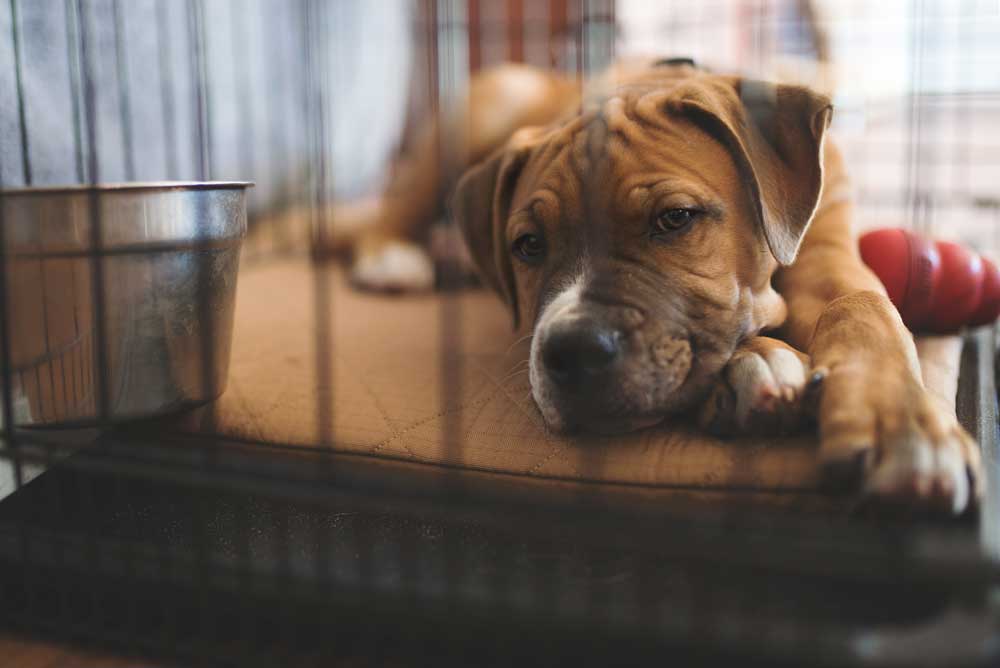
When learning how to potty train a dog or how to potty train a puppy, most articles focus on tips for potting training a puppy on having access to a backyard. But what about those who live in apartments or don’t have access to their backyard? Not to worry, there are other ways on how to potty train a puppy if you don’t have a backyard.
Training out of a crate is another efficient way teach your puppy toilet etiquette. When choosing a crate it’s vital to choose one that is the right size, all they need is space to stand up, turn around and lie down, if there is anymore room it will encourage them to relieve themselves in one corner and sleep in the other. Puppies can be timid and won’t love the idea of staying in a crate for periods of time so it’s important to integrate them instead of just forcing them into the crate. Start by tossing a treat into the crate and letting your puppy go inside and out of the crate, gradually work up to your pet spending 10 minutes in the crate and then longer as they become more comfortable. The goal is to have your puppy identify the crate as their living space. This will reduce a lot of risk associated with the puppy using the crate as a bathroom, they will look at their crate as a space where they rest and sleep and not an area to relieve themselves.
Pad Or Paper Training A Puppy
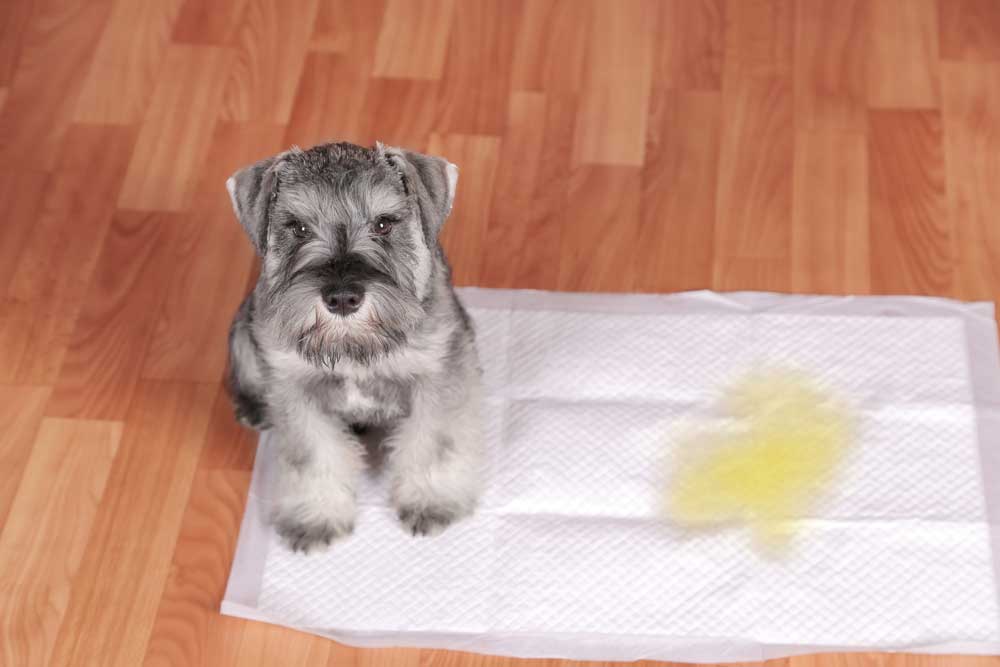
It’s one of the most difficult things to learn if you’re a new dog owner: How to paper train a puppy. When you’re pad training your puppy, paper training your puppy or teaching them to use a puppy peeing crate, patience is the name of the game. Accidents WILL HAPPEN, even if you’re an experienced paper training puppy expert.
With these things in mind, pad training your puppy can be easy if you commit to the following tricks:
- Be consistent
- Be positive and happy
- Be supportive
- Most of all, be patient!
Learning how to paper train a puppy is one of those frustrating things almost all dog owners have to go through. But how can you learn to become a paper training puppy pro. When setting up a puppy pad it’s important to set it up in an area that can be easily cleaned, avoiding carpets will create a lot less mess. Set the pee pads in a corner of the room and on the opposite corner set up their bed. As the puppy begins to use the pee pads you need to make sure you are changing them often, when you do change them leave a small piece of soiled pad on top of the clean pads so your pup knows where to go next time. Continue removing pads until there is only one or two sheets remaining. Now you’re ready to transition your pup to peeing either indoors or on patio grass by moving the pee pads near the spot where you want them to permanently pee.
Be Patient When Learning How To Potty Train A Puppy
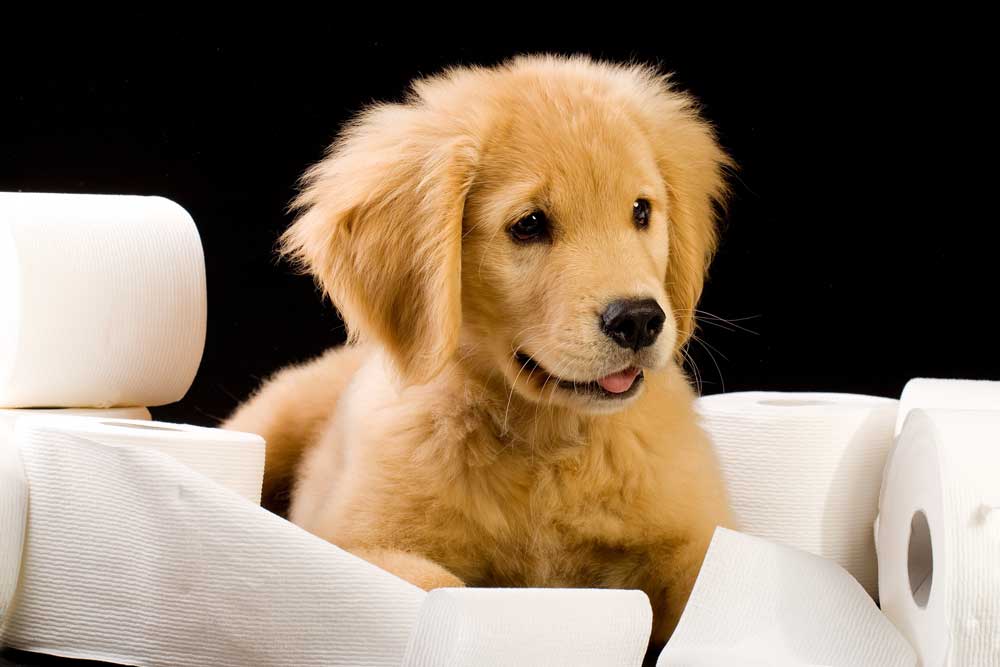
While learning how to potty train a dog, dog owners need to realize that accidents are going to happen, no matter how hard we try to prevent them. It’s important to recognize when your pet is stressed and identifying what triggers those accidents. Potty training takes time and patience, anytime you feel your puppy is straining off course, revert back to the basics of how to potty train a dog. Developing a routine, exercise and staying positive with your puppy will ensure that all the training will pay off.
FAQ’s
How long does it take to train a dog?
Depending on your dog’s breed, age, diet and mannerisms training can be accomplished in a matter of weeks-months. The average duration of training sessions can range from 3-5 weeks, but it’s best to not set expectations too specifically – every dog responds to training differently. It’s important to have patience but also be creative and adaptive to your dog’s individual needs.
How long after eating do puppies poop?
On average, puppies will need to go outside to pee or poo within 30 minutes to an hour. Especially with puppies, it’s always a good idea to let them out as often as you can to avoid any accidents.
How to start potty training dogs at night?
You’ll need to get up throughout the night unless you invest in paper training your puppy or teaching your puppy peeing in crates on pads. To begin, designate an area for pee pads or paper, and take your dog to urinate/defecate on this pad. A few times a night – until they’re familiar with the pad/paper – sit with your dog and reward them for doing their business on the pad with a treat or just good old affection & acknowledgement. Repetition is the name of the game when it comes to puppy potty training in crates, pads or with paper.
How to toilet train a puppy?
Toilet training is a particularly difficult method of potty training your pooch, but it can be done. To start training this way, take your dog to the toilet as soon as they’re up in the morning and place them on the toilet seat. In the beginning, your dog will likely not know what you expect them to do on the toilet, but if you time it correctly with their usual “outside time” your canine can take to this kind of potty training for dogs quicker than you’d expect.
Why do dogs pee in the house after being potty trained?
Sometimes dogs that used to be house trained can all of the sudden start having accidents again. Puppies peeing in crates, paper trained puppies and puppy potty crate trained dogs are usually safe in the house once they’ve been trained, and yet old age in dogs can lead to accidents. Certain health conditions, such as irritable bowel syndrome, bladder infections and many others can have sporadic urination/defecation as symptoms. If you dog develops a “bathroom” problem out of the blue, it’s important to get your canine to the vet as this might be an indication of something more serious.

